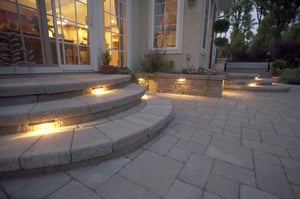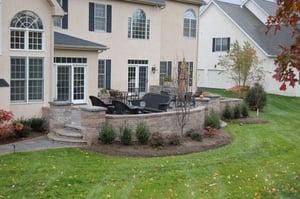 Every year we get calls from prospective clients across Chester, Bucks, Delaware County (and northern Delaware) in need of having their paver patio steps repaired/replaced, and before I even get out to the site, I already know what I’m going to find when I get there.
Every year we get calls from prospective clients across Chester, Bucks, Delaware County (and northern Delaware) in need of having their paver patio steps repaired/replaced, and before I even get out to the site, I already know what I’m going to find when I get there.
Almost universally it’s one of two problems we’re being called in to fix; either the previous contractor built the steps so that the home’s sheathing is being used as a retaining wall to hold back/up (something it was never designed or intended to do), or the steps were built when the home was new and the subsoil's beneath the steps consisted of 8-10 feet of uncompacted fill and now it’s settled several inches and is falling apart. And many times what you cannot see is improper water protection, and that can lead to mold.
Poorly constructed paver steps
But the bigger problem, using the thin wooden sheathing of the home to retain the packed crushed stone on the back side of the step, can have several negative consequences, not the least of which is the bowing of the sheathing (5/8″ OSB was NOT made to be a retaining wall) and subsequent settling of your steps into the void that the bowing creates.
The biggest impact is the moisture retention. Homes are built with the wood sheathing above ground for a reason – too much contact with moisture and the sheathing and studs, the lumber that is the structure of your home, will rot. When repairing these steps we often have to replace portions of the sheathing and occasionally portions of the rim joist!
So what’s the right way to build steps?
Your steps shouldn’t ever rely on the parts of your home that are made from wood for their support. Ever. They should be self-supporting and free standing (unless tied via rebar to your home’s concrete foundation, which is

perfectly acceptable and sometimes necessary). We like to build ours so that there’s a small space (up to 1/2″) between the steps and the house structure, to ensure there’s adequate ventilation and no future rot issues. We also like to “trim out” the siding around the steps – it makes for a cleaner looking installation and prevents future problems should you decide to replace your siding (there’s no way you’d be able to remove or install siding behind the step afterward). When done properly you should never be able to see that the steps are actually independent from your home, from the top it should look connected. The same concept applies when building a raised patio (see picture on right).
 We’d like to think we build some of the better steps in Chester, Bucks, Delaware County (and northern Delaware). If you plan includes replacing, repairing, or a new set of steps that abut you home and a perspective contractor is not discussing the proper way to build steps, you know they are not experienced enough to handle the project. Choosing an unqualified hardscape contractor can cost many times the original price to make it right down the road.
We’d like to think we build some of the better steps in Chester, Bucks, Delaware County (and northern Delaware). If you plan includes replacing, repairing, or a new set of steps that abut you home and a perspective contractor is not discussing the proper way to build steps, you know they are not experienced enough to handle the project. Choosing an unqualified hardscape contractor can cost many times the original price to make it right down the road.

